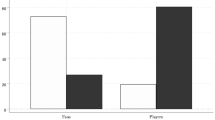Abstract
Digraph games are cooperative TU-games associated to domination structures which can be modeled by directed graphs. Examples come from sports competitions or from simple majority win digraphs corresponding to preference profiles in social choice theory. The Shapley value, core, marginal vectors and selectope vectors of digraph games are characterized in terms of so-called simple score vectors. A general characterization of the class of (almost positive) TU-games where each selectope vector is a marginal vector is provided in terms of game semi-circuits. Finally, applications to the ranking of teams in sports competitions and of alternatives in social choice theory are discussed.
Similar content being viewed by others
REFERENCES
Borm, P., R. van den Brink, R. Levínský, and M. Slikker (2000). On Two New Social Choice Correspondences, CentER Discussion paper 2000-125, Tilburg University, Tilburg.
Brink, R. van den, and R.P. Gilles (2000). Measuring Domination in Directed Networks, Social Networks 22: 141–157.
Derks, J., H. Haller, and H. Peters (2000). The Selectope for Cooperative TU-Games, International Journal of Game Theory 29: 23–38.
Gould, R.V. (1987). Measures of Betweenness in Non-Symmetric Networks, Social Networks 9: 277–282.
Hammer, P.L., U.N. Peled, and S. Sorensen (1977). Pseudo-Boolean Functions and Game Theory. I. Core Elements and Shapley Value, Cahiers du CERO 19: 159–176.
Harsanyi, J.C. (1959). A Bargaining Model for Cooperative n-Person Games, In Contributions to the Theory of Games IV (eds. Tucker A.W., and R.D. Luce), Princeton UP, Princeton pp 325–355.
Ichiishi T. (1981). Super-modularity: Applications to Convex Games and the greedy algorithm for LP, Journal of Economic Theory 25: 283–286.
Laffond G., J.F. Laslier and M. LeBreton (1993). The Bipartisan Set of a Tournament Game, Games and Economic Behavior 5: 182–201.
Sen, A.K. (1979). Collective Choice and Social Welfare, North Holland Publishing Company, Amsterdam, The Netherlands.
Shapley, L.S. (1953). A Value for n-Person Games, Annals of Mathematics Studies 28 (Contributions to the Theory of Games Vol. 2) (eds. H.W. Kuhn and A.W. Tucker), Princeton University Press, 307–317.
Shapley, L.S. (1971). Cores of Convex Games, International Journal of Game Theory 1: 11–26.
Vasil'ev, V.A. (1981). On a Class of Imputations in Cooperative Games, Soviet. Math. Dokl. 23: 53–57.
White, D.R. and S.P. Borgatti (1994). Betweennes Centrality Measures for Directed Graphs, Social Networks 16: 335–346
Author information
Authors and Affiliations
Rights and permissions
About this article
Cite this article
van den Brink, R., Borm, P. Digraph Competitions and Cooperative Games. Theory and Decision 53, 327–342 (2002). https://doi.org/10.1023/A:1024162419357
Issue Date:
DOI: https://doi.org/10.1023/A:1024162419357




